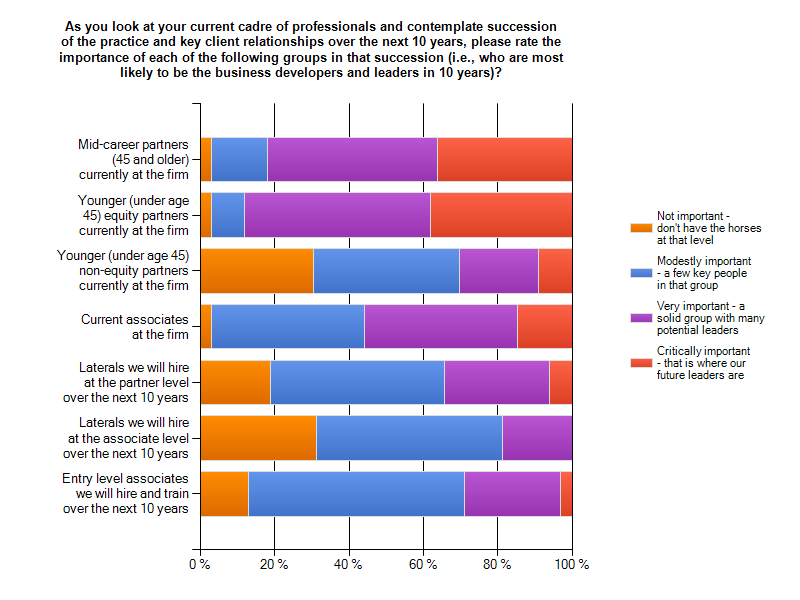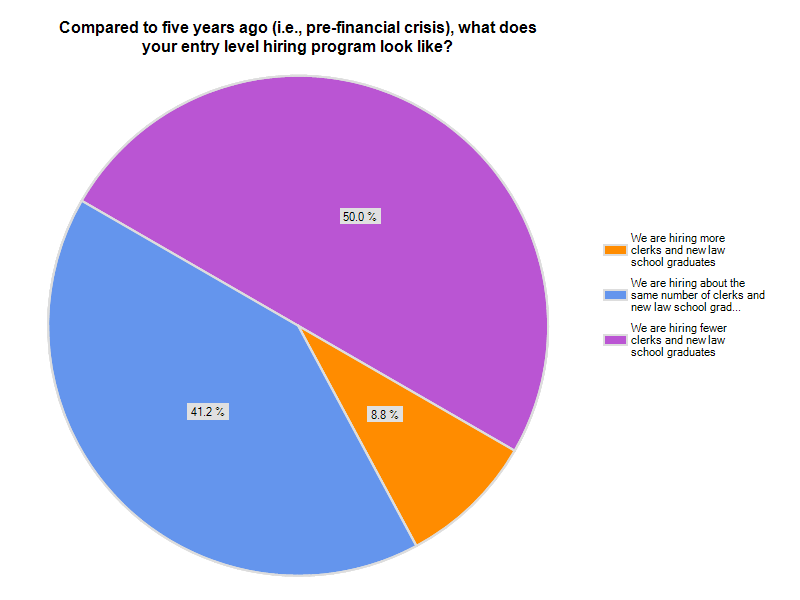Our strategy topic for the November 2012 focused on where the future leaders of law firms will be coming from. There is a simple industry wide issue relative to generational demographics. A very large cohort of baby boomer partners will be retiring over the next 20 years. In fact, by 2020 (eight years from now) half of the boomer cohort will be 65 or older. If you look at the broader demographics, the generational cohorts create something akin to a roller coaster.
- Baby Boomers are a large cohort of over 80 million people
- Generation Xers are a smaller cohort of roughly 60 million people
- Millennials are a large cohort of over 80 million (similar in size to the boomer generation – with many still in high school)
So, how do you overcome the overall industry (and societal) demographics to ensure you have strong people across all generational cohorts? Our findings point emphatically to the value of hiring and developing ‘lifers’ (i.e., people who stay with the firm they join at the entry level). In other words, the best path to ensuring you have great people across the generations is to hire and develop your own! To quote a couple of respondents:
- “We are blessed with strength throughout the demographic ranks, as well as a culture that is attracting like minded star/potential star laterals. We highly value having high quality lawyers at all levels (including entry level), training and mentoring, and making it such that all who work here can, if they do their parts, make a career at our firm.”
- “(Our future leaders are) most likely from “lifers”. We have a good group of them.”
Firms who reported that 50% of more of their current attorneys are ‘lifers’ (let’s call those firms ‘high lifers’) are dramatically more confident in the future prospects of their young people. Asked the importance of various generational cohorts in future succession (i.e., who are most likely to produce business developers and leaders over the next 10 years):
.
- ‘High lifers’ are three times as likely to consider their current associates to be a very or critically important source of future leaders (compared to ‘fewer lifer’ firms).
- Similarly, ‘high lifers’ are 3.5 times as likely to have confidence in associates that they ‘plan to hire and train in the next ten years.’
- ‘Fewer lifers’ on the other hand only truly have confidence in their mid-career (over 45) and younger equity partners.
More broadly, no one expresses much confidence in the ability of future lateral hires to be key players in 10 years. However, there were firms anecdotally expressing great confidence in their laterals.
.
- “We have grown over the last 10 years 200%, mainly from lateral hires. It is from this group that we see our future leaders.”
- “(Our future leaders will be) highly successful laterals that subscribe to our business philosophies and firm culture.”
In addition, there is not much confidence in the future prospects of younger (under 45) non-equity partners. While not entirely surprising, the lack of confidence in non-equity partners raises enough questions about their long term role(s) to fill its own blog post.
.
Hiring at the entry level has been consistently lower across the industry – as compared to pre-recession levels. The following pie chart explains why that condition persists quite clearly.
Finally, a couple of respondents looked into the proverbial crystal ball and offered predictions about where the future generation of law firm leaders will emerge.
.
- “They will come from the middle tier of law schools, they will have worked their way thru college and law school, they will have started working early in their teens and understand how to make a dollar. They will display a high level of emotional intelligence and a majority will be women.”
- “From those who have a business/entrepreneurial bent as opposed to simply applying a legal analysis to a set of facts.”
As always we thank those who took the time to share their insights with peers and colleagues. Comments are open and we welcome your emails and phone calls as well.
…



